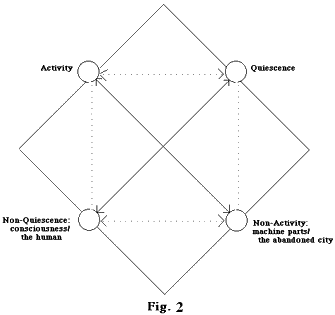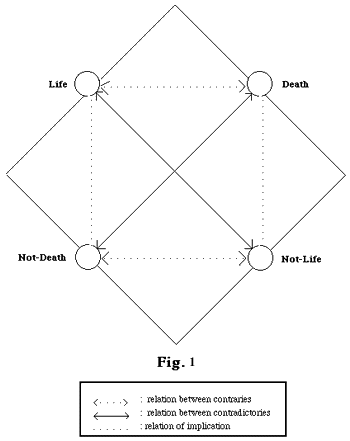
ACCORDING TO GREIMAS, the semiotic square is the elementary structure of signification, marking off the oppositional logic that is at the heart of both narrative progression and semantic, thematic, or symbolic content. The semiotic square has proven to be an influential concept not only in narrative theory but in the ideological criticism of Fredric Jameson, who uses the square as "a virtual map of conceptual closure, or better still, of the closure of ideology itself" ("Foreword" xv). (For more on Jameson, see the Jameson module on ideology.)
Greimas' schema is useful since it illustrates the full complexity of any given semantic term (seme). Greimas points out that any given seme entails its opposite or "contrary." "Life" (s1) for example is understood in relation to its contrary, "death" (s2). Rather than rest at this simple binary opposition (S), however, Greimas points out that the opposition, "life" and "death," suggests what Greimas terms a contradictory pair (-S), i.e., "not-life" (-s1) and "not-death" (-s2). We would therefore be left with the following semiotic square (Fig. 1):
As Jameson explains in the Foreword to Greimas' On Meaning, "-s1 and -s2"—which in this example are taken up by "not-death" and "not-life"—"are the simple negatives of the two dominant terms, but include far more than either: thus 'nonwhite' includes more than 'black,' 'nonmale' more than 'female'" (xiv); in our example, not-life would include more than merely death and not-death more than life. Indeed, in a given narrative, alternative terms will often suggest themselves for -s1 and -s2. As I explain my application of Greimas' theories, we can infer in even a simple phrase like "the road is clear" an implied dominant binary, "activity (s1) and quiescence (s2)." Were we reading a narrative where we find a post-apocalyptic world in which the last surviving humans are presented walking through a series of deserted streets in which they must fight the machines that have taken over, the contradictory seme not-activity (-s1) might be taken up by machine parts or the abandoned city itself. Not-quiescence (-s2) could conversely be taken up by human consciousness. Our semiotic square would therefore look something like this (Fig. 2):

Such a semiotic square might in turn be tied to other dominant binary oppositions in the narrative, including quite possibly "life and death." As Greimas explains, "nothing permits us to assert that a semiotic manifestation is dependent on only one system at a time. And so far as it is dependent on several, its closure can be attributed to the interaction of the different systems that produce it" (60). In other words, one can construct a series of, say, three semiotic squares that explore various levels of a story's manifested diegesis, each semiotic square related to the next.
Narratives will also tend to find figures that resolve the implied oppositions of a given semiotic square. The union of the dominant binary (S), here "activity" and "quiescence," will often be reserved for the utopic solution for the problems of the work's diegesis, perhaps represented in the hero of the tale; in our hypothetical sci-fi narrative, perhaps the hero is able at the end of the story to reconstruct the pre-apocalyptic bourgeois lifestyle that saw the balance of work and leisure (or activity and quiescence) as the principle of human freedom. The resolution of the opposition, "activity (s1) and the human (-s2)," might be taken up in the story by, for example, a slave force; the resolution of the opposition, "quiescence (s2) and machine parts (-s1)," might be represented by the use of humans as batteries for the machine (as in The Matrix). Finally, the resolution of the combination not-quiescence (-s2) and not-activity (-s1) might be taken up by the central A.I. that runs the post-apocalyptic world (as in Neuromancer's Wintermute), a figure that would also inhabit the contradictory space of both not-life and not-death. As Jameson continues, "The entire mechanism then is capable of generating at least ten conceivable positions out of a rudimentary binary opposition (which may originally have been no more than a single term, e.g., 'white,' which proves to be internally defined by a hidden opposition we articulate by promoting the concealed pole 'black' to visibility)" (xiv-xv). In our hypothetical sci-fi narrative, the ten terms would be: activity, quiescence, non-activity, the abandoned machine, non-quiescence, human consciousness, A.I., human slaves, human batteries, and the utopic hero.
Greimas illustrates how all sorts of phenomena are organized by this semiotic logic. A good non-literary example is the logic of traffic lights in Europe. In Europe, Greimas explains (52-53), the yellow light has two functions: when a yellow light follows green, you are expected to slow down and prepare to stop (as in the United States and Canada); when a yellow light follows a red light, you are warned to get ready to move forward. As Greimas explains, the green light (s1) is, in this example, in a contrary relation to the red light (s2). The green light represents "prescription" or a "positive injunction" (cross!); the red light represents an "interdiction" or a "negative injunction" (don't cross!). In the European system of lights, we are also given both possible contradictory pairs (-s1 and -s2): when the yellow light follows green, the signal is a nonprescription (get ready to stop!); when the yellow light follows red, the signal is a noninterdiction (get ready to go!). If the yellow light stands alone without changing, it assumes the neutral position: both a nonprescription and a noninterdiction (get ready to stop if you see someone crossing but be ready to go if you see no one!). Greimas' point is that we are all constrained by the finite series of possibilities opened up by such semiotic oppositions: "An author, a producer of any semiotic object, operates within an epistemy, which is the result of his individuality and the society in which he is inscribed. Within this society it is possible for him to make a limited number of choices, which have as an initial result the investment of organized contents, that is, contents endowed with valencies (possibilities of relations)" (61).
For another example of a semiotic square, see my reading of the Dürer image associated with this Introduction to Narratology.
